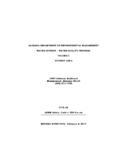Transcription of City of St. Louis Water Division – Department of Public ...
1 city of St. Louis Water Division Consumer Confidence Report 2019 city of St. Louis Water Division Department of Public Utilities 1640 S. Kingshighway St. Louis , MO 63110-4399 314-663-9000 Curtis B. Skouby Director of Public Utilities Curtis B. Skouby Water Commissioner 2 city OF ST. Louis Water Quality Report 2019 In compliance with the Safe Drinking Water Act, the city of St. Louis Water Division is delivering this Water Quality Report to all its customers who receive Water bills. We ask that landlords, employers, and anyone else who receives the Water bill for other Water users share this report with them.
2 To obtain additional copies, call (314) 771-2255. The web address of the CCR on the internet is: The report summarizes information that your Water system collects to comply with regulations, including information on Water from the Missouri and Mississippi Rivers, the levels of detected contaminants, and compliance with drinking Water rules. ST. Louis city Water - A HISTORY OF EXCELLENCE The Water Division is a branch of the St. Louis city government s Department of Public Utilities. Since 1835, we have been dedicated to supplying the highest quality Water to our customers.
3 We are proud to say that in 2019, our Water met or exceeded the standards set by the Environmental Protection Agency and the Missouri Department of Natural Resources. In fact, we have never violated a Water quality regulation in 115 years of testing. Our scientists constantly monitor and test the Water for over 150 possible contaminants. We analyze the Water where it enters the plant as raw river Water , throughout the treatment process, and at multiple points throughout the city . The frequency and thoroughness of these tests exceed federal regulations for Water quality monitoring.
4 Water quality monitoring of St. Louis city Water in 2019 indicated that no compounds were detected above the allowable levels set by federal and state regulations. The city of St. Louis Water Division is proud to be a charter member of the Partnership for Safe Water . In 1994, this organization was formed by 187 surface Water utilities, several drinking Water organizations, including the American Water Works Association and the Environmental Protection Agency. The Partnership s goal is to provide a new measure of safety to millions of Americans by improving Water quality nationwide.
5 WHERE DOES THE Water COME FROM? The city of St. Louis Water Division has two Water treatment plants. The Howard Bend Plant draws Water from the Missouri River. The Chain of Rocks Plant is located on the Mississippi River, south of the confluence of the Missouri and Mississippi Rivers. The Water reaching our intakes at the Chain of Rocks Plant is primarily Missouri River Water because the two rivers have not fully mixed when the Water reaches the plant. Together, the two plants produce an average of 111 million gallons of Water each day. 3 SOURCE Water ASSESSMENT INFORMATION In 2004, the Missouri Department of Natural Resources (DNR) conducted a source Water assessment to determine susceptibility of our source Water to contamination.
6 You can acquire the complete results by calling DNR at 1-800-361-4827 or the information can be viewed on the internet at: Our system is: 6010715. The assessment has determined that our river Water source is susceptible due to the presence of potential contaminant sources. The city of St. Louis employs all available measures at its disposal to remove contamination at intakes and during the treatment process. The drinking Water produced at our facilities consistently meets or exceeds all Safe Drinking Water Standards.
7 WHAT ABOUT CONTAMINANTS? All drinking Water , including bottled Water , may reasonably be expected to contain at least small amounts of some contaminants. The presence of contaminants does not necessarily indicate that Water poses a health risk. More information about contaminants and potential health effects can be obtained by calling the Environmental Protection Agency s Safe Drinking Water Hotline (800-426-4791). GIARDIA AND CRYPTOSPORIDIUM Giardia and Cryptosporidium are microscopic parasites that, when ingested, can result in fever, diarrhea, and other gastrointestinal complications.
8 These organisms are found in all rivers and streams and come from animal wastes in the watershed. They are removed by effective treatment including deactivation with chlorine and precipitative softening, sedimentation, flocculation and filtration. Previous monitoring performed monthly did not detect any Cryptosporidium or Giardia in samples collected after the first stage of our multi-stage, multiple barrier treatment process at either of the city s Water purification plants. Prior monitoring showed that neither cysts nor oocysts were detected in our finished Water .
9 HEALTH RISKS Some people may be more vulnerable to contaminants in drinking Water than the general population. Immuno-compromised persons can be particularly at risk from infections; such as persons with cancer undergoing chemotherapy, persons who have undergone organ transplants, people with HIV/AIDS or other immune system disorders, some elderly individuals, and infants. These people should seek advice about drinking Water from their health care providers. EPA/Center for Disease Control guidelines on appropriate means to lessen the risk of infection by Cryptosporidium are available from the Safe Drinking Water Hotline (800-426-4791).
10 4 LEAD IN DRINKING Water The city of St. Louis Water Division has optimized its treatment process so that the corrosion of internal plumbing is highly unlikely. However, if present, elevated levels of lead can cause serious health problems, especially for pregnant women and young children. Lead in drinking Water is primarily from materials and components associated with service lines and home plumbing. The city of St. Louis Water Division is responsible for providing high quality drinking Water , but cannot control the variety of materials used in plumbing components.







